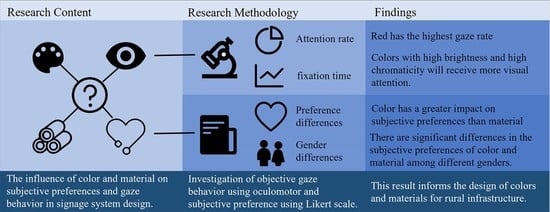Design Element Preferences in Public Facilities: An Eye Tracking Study
Abstract
1. Introduction
1.1. Color Research in Public Facility Design
1.2. Material Research in Public Facility Design
1.3. Application of Eye-Tracking Technology in the Design of Public Facilities
2. Materials and Methods
2.1. Conceptual Framework
2.2. Selection of Research Subjects
2.3. Sampling and Data Collection
2.3.1. Color Changes of the Logo
2.3.2. Material Changes to the Logo
2.3.3. Crossover Effect
2.4. Experimental Design
2.4.1. Eye Movement Experiment
2.4.2. Subjective Questionnaires
2.4.3. Data Analysis
3. Results
3.1. Physiological Aspect—Objective Attention to Data
3.1.1. Attention Rate
3.1.2. Attention Time
3.2. Psychological Dimension—Subjective Evaluation Data
3.2.1. Multi-Factor Analysis of Variance
3.2.2. Color
3.2.3. Materials
3.3. Demographic Differences
3.3.1. Gender and Color
3.3.2. Gender and Material
3.3.3. Professionalism
3.4. Correlation between Objective Gaze and Subjective Preferences
3.5. Verification
4. Discussion
4.1. Theoretical Significance
4.2. Practical Implications
4.3. Limitations and Future Research
5. Conclusions
- Both color and material affect gaze behavior, and color has more influence than material. The impact of color is primarily reflected in hue. The red logo receives the most attention from the audience. It demonstrates that high-luminance and -chromaticity colors will attract greater visual attention. The effect of the material is mainly represented in its texture and contrast with the surrounding environment; the more intricate the texture and the greater the contrast with the surrounding environment, the more visual attention the material will draw.
- Both color and material affect subjective preferences, with the influence of color being greater than that of material. Regarding color, tourists prefer red with high brightness and purity, which aligns with the traditional culture of Jiangnan, where red is used for decorative embellishments such as lanterns and window flowers. The visitor group perceives different materials, among which metal is loved due to its luminosity and technology, and plaster is loved due to its heavy, solid texture and being in line with Jiangnan culture.
- A considerable link exists between subjective preference and objective gaze (visitors will pay more attention to the preferred logo). It indicates that visitors prefer more visually striking colors and materials, which aligns with the need for the logo to stand out and draw attention to its function [42].
- The overall subjective preferences of color and material are similar, but there are a few differences in terms of gender. In terms of color, Asian women are more inclined towards Western color preferences. For example, women are significantly more receptive to white than men [53]. In terms of material, men prefer acrylic and metal, while women prefer wood and plaster. It indicates that men prefer relatively technological and contrasting colors and materials with their surroundings, while women prefer relatively natural and temperate colors and materials.
Supplementary Materials
Author Contributions
Funding
Data Availability Statement
Acknowledgments
Conflicts of Interest
References
- Allen, E.; Rand, P. Architectural Detailing: Function, Constructibility, Aesthetics; John Wiley & Sons: Hoboken, NJ, USA, 2016. [Google Scholar]
- Scruton, R. The Aesthetics of Architecture; Princeton University Press: Princeton, NJ, USA, 2021. [Google Scholar]
- Lynch, K. The Image of the City; MIT Press: Cambridge, MA, USA, 1964. [Google Scholar]
- Aydoghmish, F.M.; Rafieian, M. Developing a comprehensive conceptual framework for city branding based on urban planning theory: Meta-synthesis of the literature (1990–2020). Cities 2022, 128, 103731. [Google Scholar] [CrossRef]
- Paliaga, M.; Franjić, Z.; Strunje, Ž. Methodology of valuation of cities’ brands. Econ. Res.-Ekon. Istraživanja 2010, 23, 102–111. [Google Scholar] [CrossRef]
- Ruan, L.; Long, Y.; Zhang, L.; Wu, X.L. A Geographic Analysis of Optimal Signage Location Selection in Scenic Area. Int. Arch. Photogramm. Remote Sens. Spat. Inf. Sci. 2016, 41, 477–481. [Google Scholar] [CrossRef]
- Qingjun, W. The scheme of Rizhao city brand. Oper. Manag. Coll. Int. Bus. Res. 2008, 1, 67–79. [Google Scholar] [CrossRef]
- Salleh, S.; Abdullah, N. Observation on signboard photographs in Kota Kinabalu, Sabah as indicator of change towards global business. J. Glob. Bus. Soc. Entrep. (GBSE) 2017, 1, 35–44. [Google Scholar]
- Rusnak, M. Applicability of eye trackers in marketing activities related to historical monuments Comparison of experts’ predictions and visual reactions of non-professionals. J. Cult. Herit. 2021, 49, 152–163. [Google Scholar] [CrossRef]
- Bell, S. Elements of Visual Design in the Landscape; Routledge: Abingdon, UK, 2019. [Google Scholar] [CrossRef]
- Emery, K.J.; Webster, M.A. Individual differences and their implications for color perception. Curr. Opin. Behav. Sci. 2019, 30, 28–33. [Google Scholar] [CrossRef] [PubMed]
- Kaiser, P.K. Physiological response to color: A critical review. Color Res. Appl. 1984, 9, 29–36. [Google Scholar] [CrossRef]
- Zhang, L.; Li, X.; Li, C.; Zhang, T. Research on visual comfort of color environment based on the eye-tracking method in subway space. J. Build. Eng. 2022, 59, 105138. [Google Scholar] [CrossRef]
- Cheng, Y.; Tan, M. The quantitative research of landscape color: A study of Ming Dynasty City Wall in Nanjing. Color Res. Appl. 2018, 43, 436–448. [Google Scholar] [CrossRef]
- Won, S.; Lee, Y.; Park, Y. The impact of signboard-building color combinations on color harmony and legibility. Color Res. Appl. 2020, 45, 527–541. [Google Scholar] [CrossRef]
- Knez, I.; Kers, C. Effects of indoor lighting, gender, and age on mood and cognitive performance. Environ. Behav. 2000, 32, 817–831. [Google Scholar] [CrossRef]
- Lin, Y.; Zeng, W.; Ye, Y.; Qu, H. Saliency-aware color harmony models for outdoor signboard. Comput. Graph. 2022, 105, 25–35. [Google Scholar] [CrossRef]
- Murphy, M. Landscape Architecture Theory; Island Press: Washington, DC, USA, 2016. [Google Scholar]
- Schneider-Marin, P.; Stocker, T.; Abele, O.; Margesin, M.; Staudt, J.; Abualdenien, J.; Lang, W. EarlyData knowledge base for material decisions in building design. Adv. Eng. Inform. 2022, 54, 101769. [Google Scholar] [CrossRef]
- Basbagill, J.; Flager, F.; Lepech, M.; Fischer, M. Application of life-cycle assessment to early stage building design for reduced embodied environmental impacts. Build. Environ. 2013, 60, 81–92. [Google Scholar] [CrossRef]
- Davis, B. The asymmetry of landscape: Aesthetics, agency, and material reuse in the Reserva Ecológica de Buenos Aires. J. Landsc. Archit. 2018, 13, 78–89. [Google Scholar] [CrossRef]
- Li, T.; Zou, G. Study of Waste Material Characteristics-Based Ecological Landscape Design. In Proceedings of the 2011 International Conference on Electric Technology and Civil Engineering (ICETCE), Lushan, China, 22–24 April 2011; IEEE: Piscataway, NJ, USA, 2011; pp. 1565–1568. [Google Scholar] [CrossRef]
- Lexcellent, C. Human Memory and Material Memory; Spring: Berlin/Heidelberg, Germany, 2019. [Google Scholar] [CrossRef]
- Suffian, S.; Dzombak, R.; Mehta, K. Future directions for nonconventional and vernacular material research and applications. In Nonconventional and Vernacular Construction Materials; Woodhead Publishing: Sawston, UK, 2016; pp. 63–80. [Google Scholar] [CrossRef]
- Xiao, C.; Hong, D. Gender differences in environmental behaviors among the Chinese public: Model of mediation and moderation. Environ. Behav. 2018, 50, 975–996. [Google Scholar] [CrossRef]
- De la Fuente Suárez, L.A. Subjective experience and visual attention to a historic building: A real-world eye-tracking study. Front. Archit. Res. 2020, 9, 774–804. [Google Scholar] [CrossRef]
- Kiefer, P.; Giannopoulos, I.; Raubal, M.; Duchowski, A. Eye tracking for spatial research: Cognition, computation, challenges. Spat. Cogn. Comput. 2017, 17, 1–19. [Google Scholar] [CrossRef]
- Quartier, K.; Vanrie, J.; Van Cleempoel, K. As real as it gets: What role does lighting have on consumer’s perception of atmosphere, emotions and behaviour? J. Environ. Psychol. 2014, 39, 32–39. [Google Scholar] [CrossRef]
- Tuszyńska-Bogucka, W.; Kwiatkowski, B.; Chmielewska, M.; Dzieńkowski, M.; Kocki, W.; Pełka, J.; Przesmycka, N.; Bogucki, J.; Galkowski, D. The effects of interior design on wellness–Eye tracking analysis in determining emotional experience of architectural space. A survey on a group of volunteers from the Lublin Region, Eastern Poland. Ann. Agric. Environ. Med. 2020, 27, 113–122. [Google Scholar] [CrossRef] [PubMed]
- Chen, B.; Gong, C.; Li, S. Looking at buildings or trees? Association of human nature relatedness with eye movements in outdoor space. J. Environ. Psychol. 2022, 80, 101756. [Google Scholar] [CrossRef]
- Song, E.-S.; Kim, W.-H.; Lee, B.-H.; Han, D.-W.; Lee, J.-H.; Kim, B. Assessment of Color Perception and Preference with Eye-Tracking Analysis in a Dental Treatment Environment. Int. J. Environ. Res. Public Health 2021, 18, 7981. [Google Scholar] [CrossRef]
- Li, Q.; Huang, Z.J.; Christianson, K. Visual attention toward tourism photographs with text: An eye-tracking study. Tour. Manag. 2016, 54, 243–258. [Google Scholar] [CrossRef]
- Sargezeh, B.A.; Tavakoli, N.; Daliri, M.R. Gender-based eye movement differences in passive indoor picture viewing: An eye-tracking study. Physiol. Behav. 2019, 206, 43–50. [Google Scholar] [CrossRef]
- Kaplan, R.; Kaplan, S. The experience of nature. In A Psychological Perspective; Cambridge University Press: Cambridge, UK, 1989. [Google Scholar]
- Ulrich, R.S. Biophilia, biophobia, and natural landscapes. In The Biophilia Hypothesis; Kellert, S.E., Wilson, E., Eds.; Island Press: Washington, DC, USA, 1993; pp. 73–137. [Google Scholar]
- Chen, W.; Ruan, R.; Deng, W.; Gao, J. The effect of visual attention process and thinking styles on environmental aesthetic preference: An eye-tracking study. Front. Psychol. 2022, 13, 1027742. [Google Scholar] [CrossRef]
- Kohout, S.; Kruikemeier, S.; Bakker, B.N. May I have your attention, please? An eye tracking study on emotional social media comments. Comput. Hum. Behav. 2022, 139, 107495. [Google Scholar] [CrossRef]
- Bohua, L.I.U.; Lishan, S.U.N.; Jian, R.O.N.G. Driver’s visual cognition behaviors of traffic signs based on eye movement parameters. J. Transp. Syst. Eng. Inf. Technol. 2011, 11, 22–27. [Google Scholar] [CrossRef]
- Szabo, F.; Bodrogi, P.; Schanda, J. Experimental Modeling of Colour Harmony; Wiley Online Library: Hoboken, NJ, USA, 2010; Volume 35, pp. 34–49. [Google Scholar] [CrossRef]
- Luffarelli, J.; Mukesh, M.; Mahmood, A. Let the logo do the talking: The influence of logo descriptiveness on brand equity. J. Mark. Res. 2019, 56, 862–878. [Google Scholar] [CrossRef]
- Calori, C.; Vanden-Eynden, D. Signage and Wayfinding Design: A Complete Guide to Creating Environmental Graphic Design Systems; John Wiley & Sons: Hoboken, NJ, USA, 2015. [Google Scholar] [CrossRef]
- Machado, J.C.; de Carvalho, L.V.; Torres, A.; Costa, P. Brand logo design: Examining consumer response to naturalness. J. Prod. Brand Manag. 2015, 24, 78–87. [Google Scholar] [CrossRef]
- Henderson, P.W.; Cote, J.A. Guidelines for selecting or modifying logos. J. Mark. 1998, 62, 14–30. [Google Scholar] [CrossRef]
- Dubois, E. The Structure and Properties of Color Spaces and the Representation of Color Images; Synthesis Lectures on Image, Video, and Multimedia Processing; Springer: Cham, Switzerland, 2009; Volume 4, pp. 1–129. [Google Scholar] [CrossRef]
- O’Connor, Z. Logo colour and differentiation: A new application of environmental colour mapping. Color Res. Appl. 2011, 36, 55–60. [Google Scholar] [CrossRef]
- Porter, T. Environmental colour mapping. Urban Des. Int. 1997, 2, 23–31. [Google Scholar] [CrossRef]
- Cohen, J. Statistical Power Analysis for the Behavioral Sciences; Routledge: Abingdon, UK, 2013. [Google Scholar] [CrossRef]
- Wang, H.; Luo, M.R.; Liu, P.; Yang, Y.; Zheng, Z.; Liu, X. A study of atmosphere perception of dynamic coloured light. Light. Res. Technol. 2014, 46, 661–675. [Google Scholar] [CrossRef]
- Lüdtke, H.; Wilhelm, B.; Adler, M.; Schaeffel, F.; Wilhelm, H. Mathematical procedures in data recording and processing of pupillary fatigue waves. Vis. Res. 1998, 38, 2889–2896. [Google Scholar] [CrossRef]
- Ram, V.; Schaposnik, L.P.; Konstantinou, N.; Volkan, E.; Papadatou-Pastou, M.; Manav, B.; Jonauskaite, D.; Mohr, C. Extrapolating continuous color emotions through deep learning. Phys. Rev. Res. 2020, 2, 033350. [Google Scholar] [CrossRef]
- Del Rio, D.F.; Sovacool, B.; Martiskainen, M. Controllable, frightening, or fun? Exploring the gendered dynamics of smart home technology preferences in the United Kingdom. Energy Res. Soc. Sci. 2021, 77, 102105. [Google Scholar] [CrossRef]
- Brams, S.; Ziv, G.; Levin, O.; Spitz, J.; Wagemans, J.; Williams, A.M.; Helsen, W.F. The relationship between gaze behavior, expertise, and performance: A systematic review. Psychol. Bull. 2019, 145, 980. [Google Scholar] [CrossRef]
- Al-Rasheed, A.S. An experimental study of gender and cultural differences in hue preference. Front. Psychol. 2015, 6, 30. [Google Scholar] [CrossRef]
- Mazzeo, R.; Cam, D.; Chiavari, G.; Fabbri, D.; He, L. Analytical study of traditional decorative materials and techniques used in Ming Dynasty wooden architecture The case of the Drum Tower in Xi’an, PR of China. J. Cult. Herit. 2004, 5, 273–283. [Google Scholar] [CrossRef]
- Wijaya, B.S. The development of hierarchy of effects model in advertising. Int. Res. J. Bus. Stud. 2015, 5, 34–49. [Google Scholar] [CrossRef]
- Yu, K. Cultural variations in landscape preference: Comparisons among Chinese sub-groups and Western design experts. Landsc. Urban Plan. 1995, 32, 107–126. [Google Scholar] [CrossRef]
- Molnarova, K.; Sklenicka, P.; Stiborek, J.; Svobodova, K.; Salek, M.; Brabec, E. Visual preferences for wind turbines: Location, numbers and respondent characteristics. Appl. Energy 2012, 92, 269–278. [Google Scholar] [CrossRef]
- Torku, A.; Chan, A.P.; Yung, E.H.; Seo, J.; Antwi-Afari, M.F. Wearable Sensing and Mining of the Informativeness of Older Adults’ Physiological, Behavioral, and Cognitive Responses to Detect Demanding. Environ. Cond. Environ. Behav. 2022, 54, 1005–1057. [Google Scholar] [CrossRef]
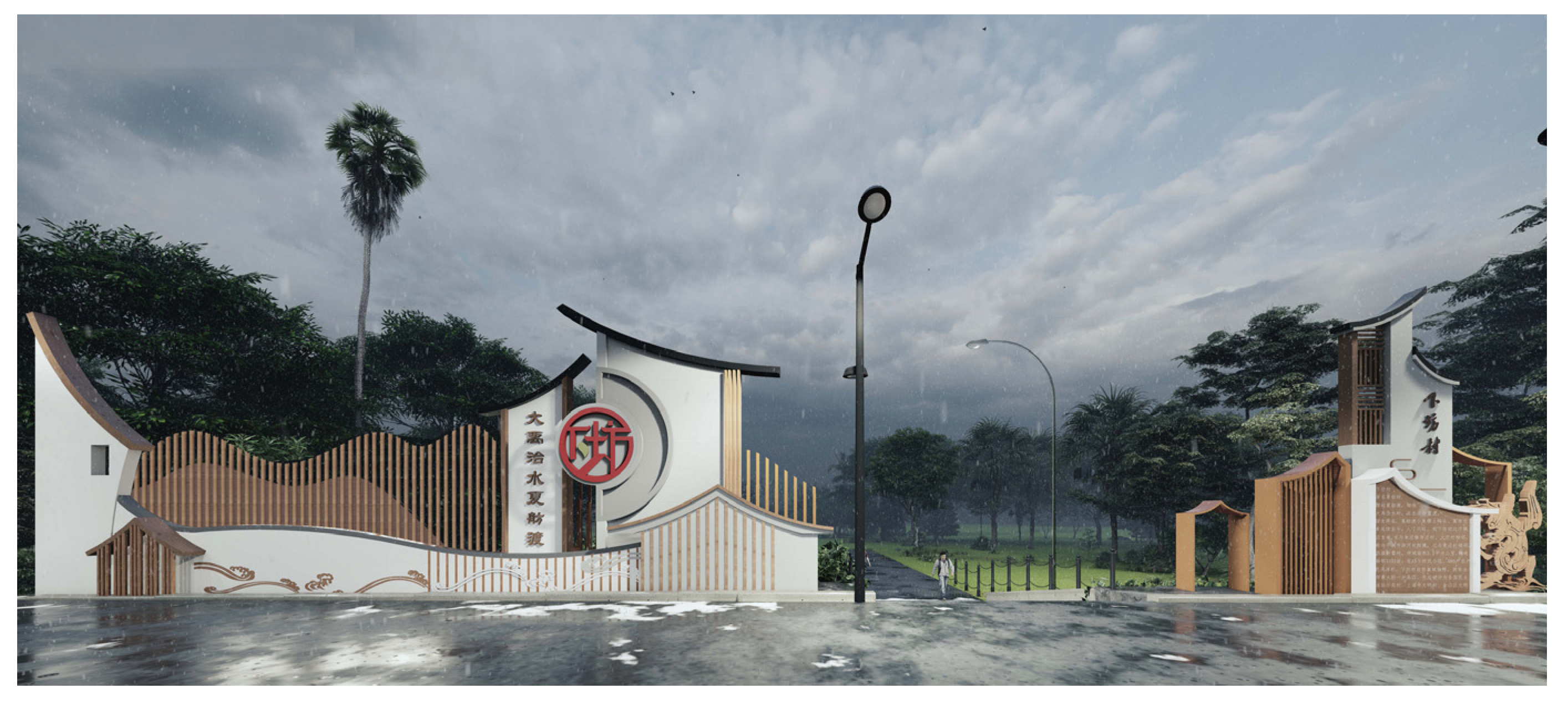

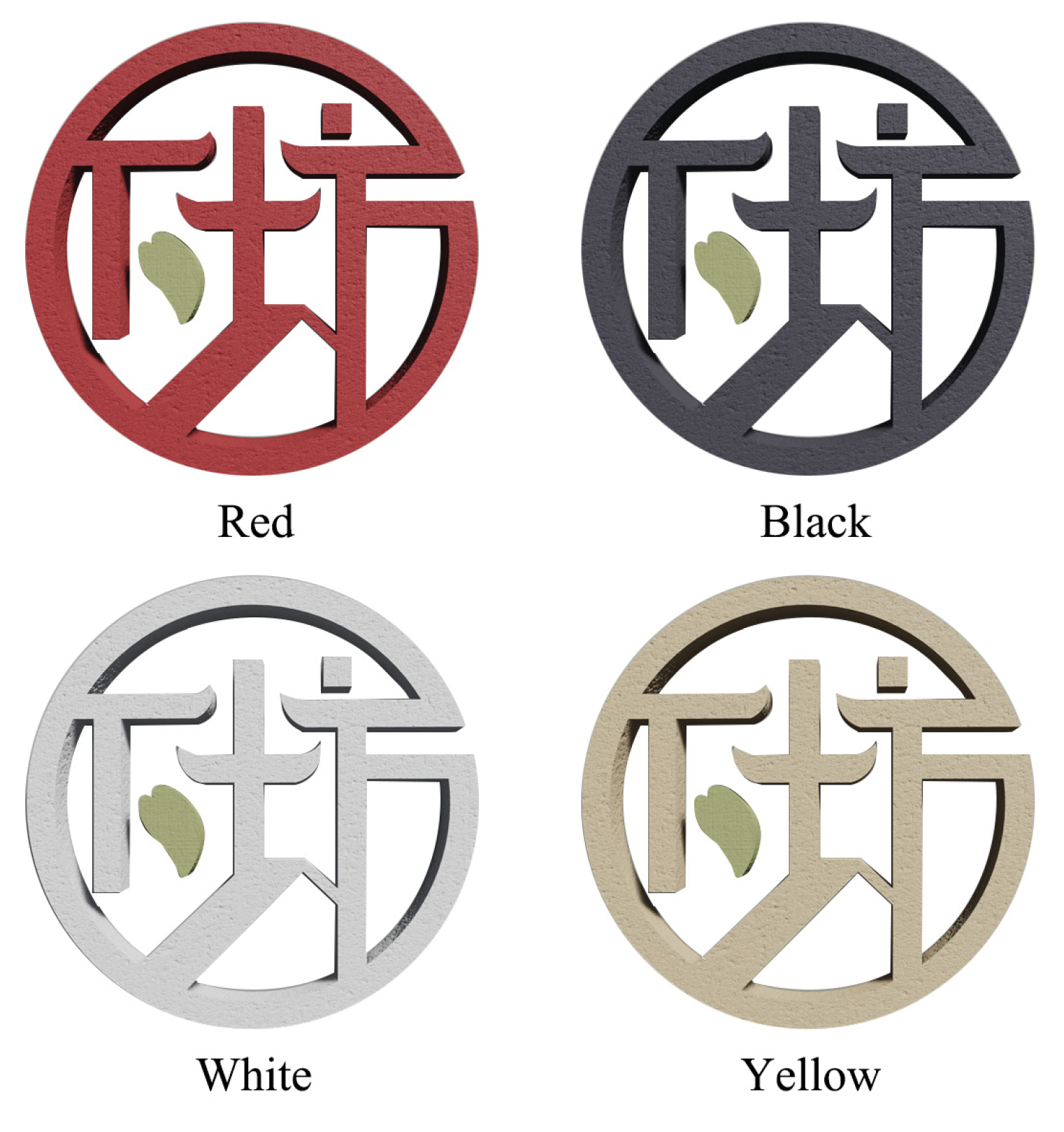
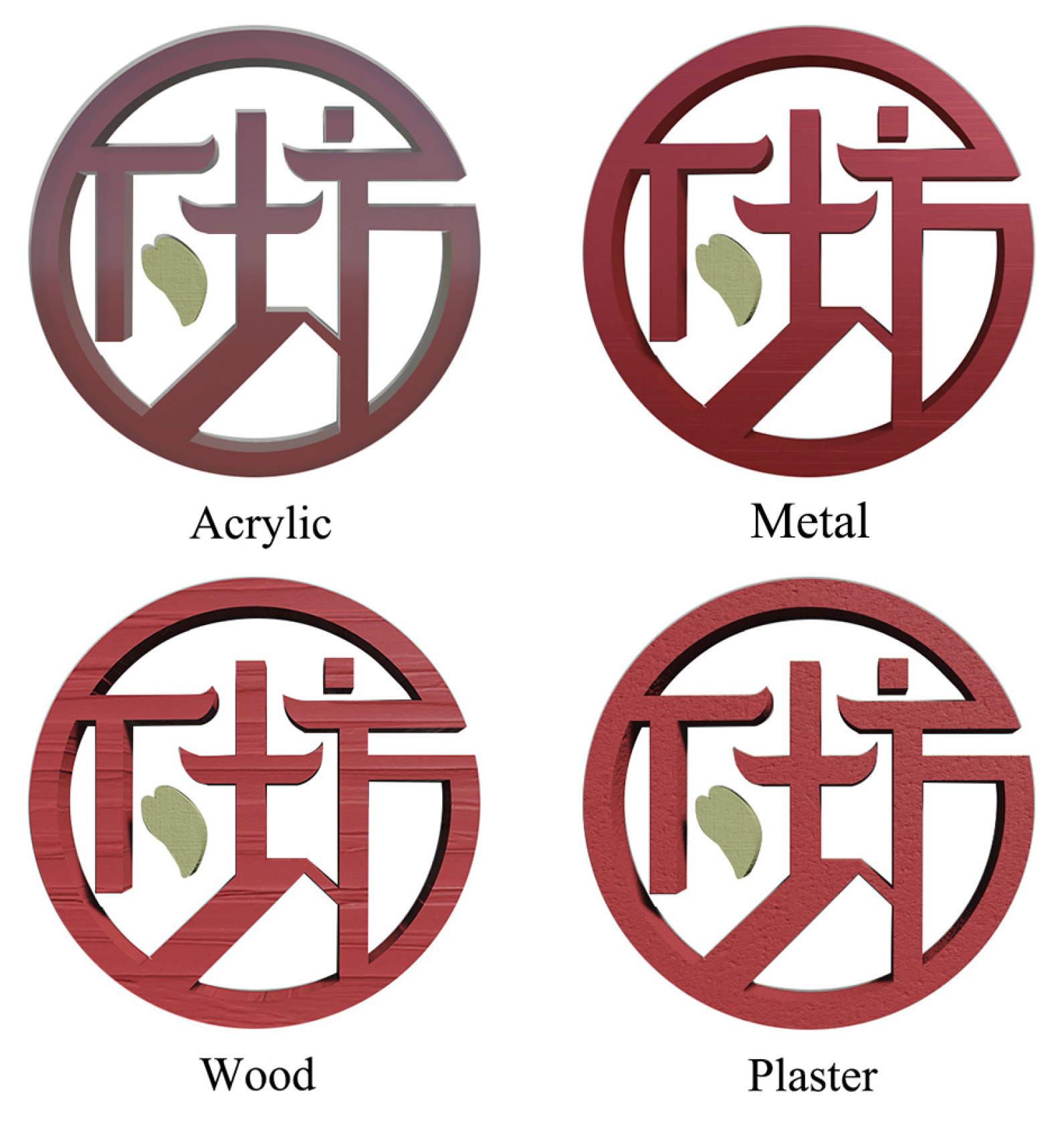
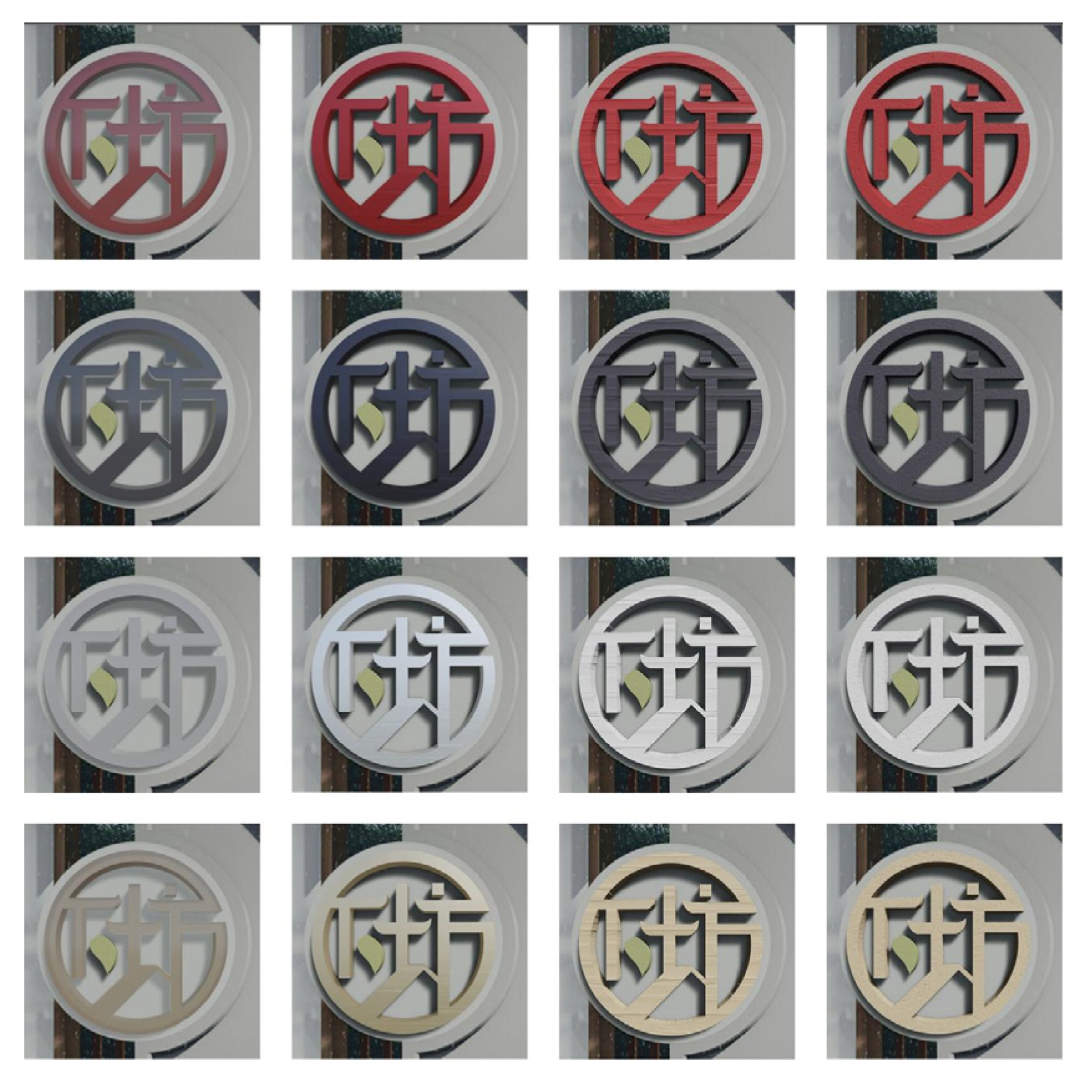

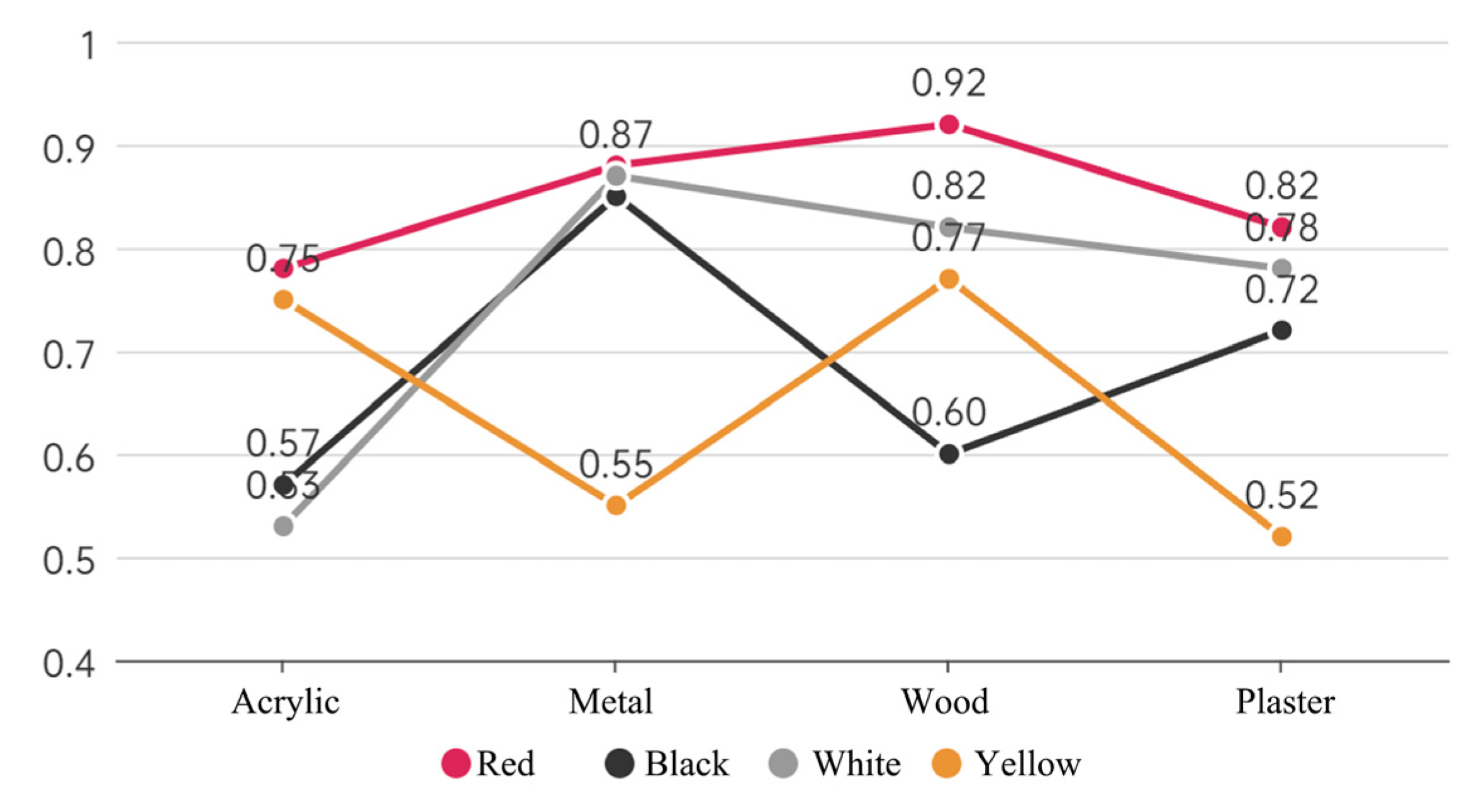
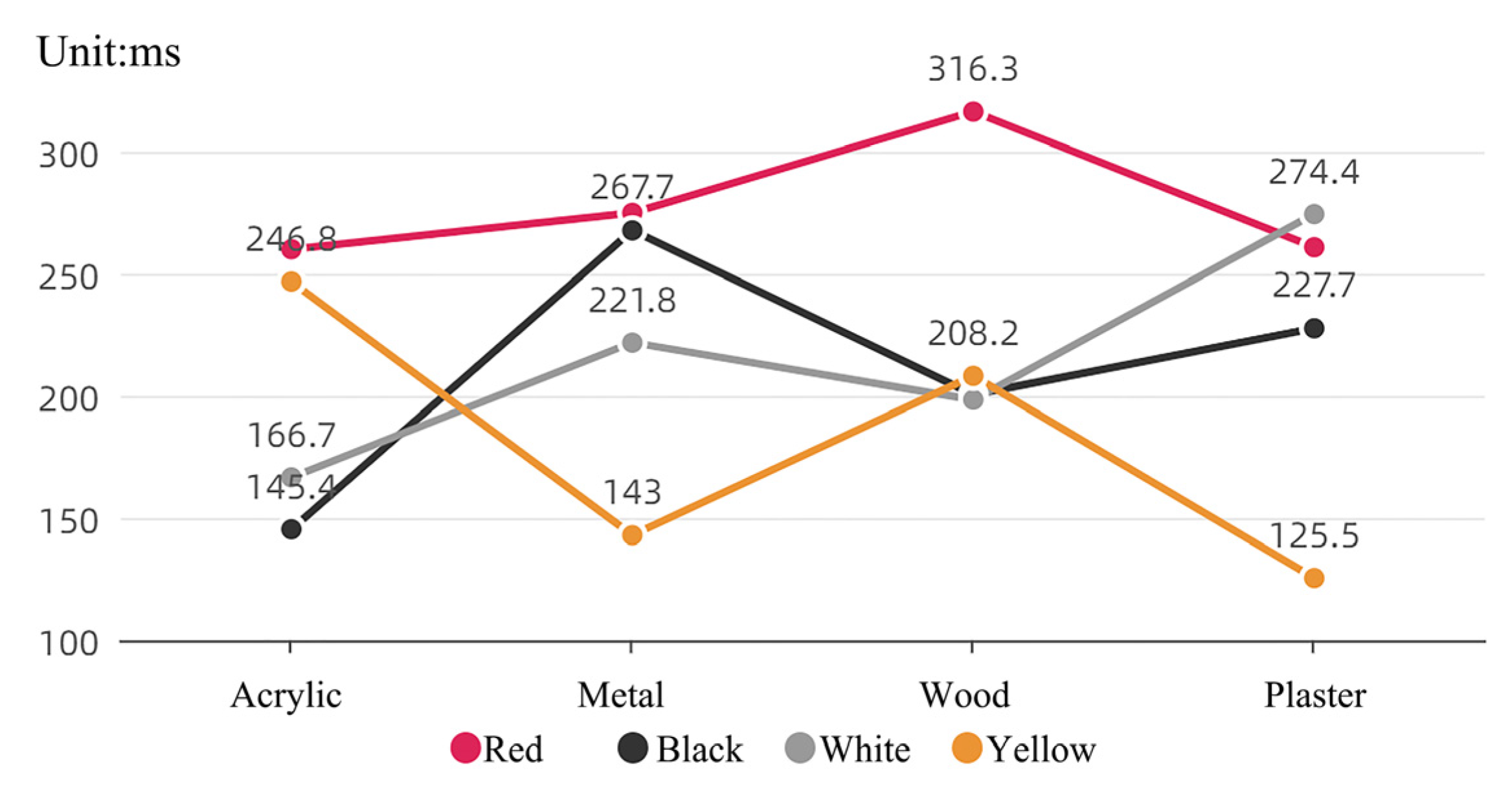
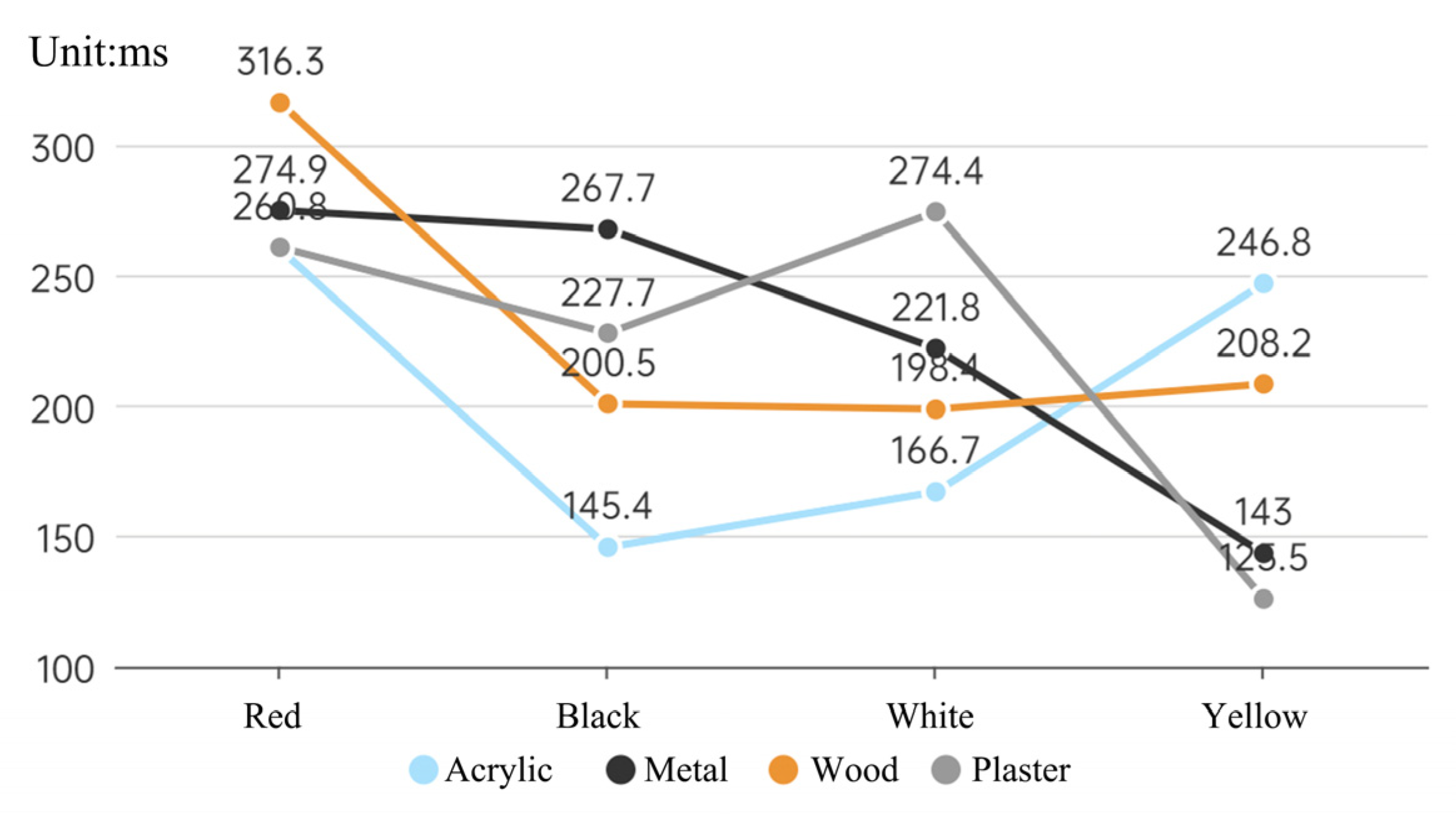
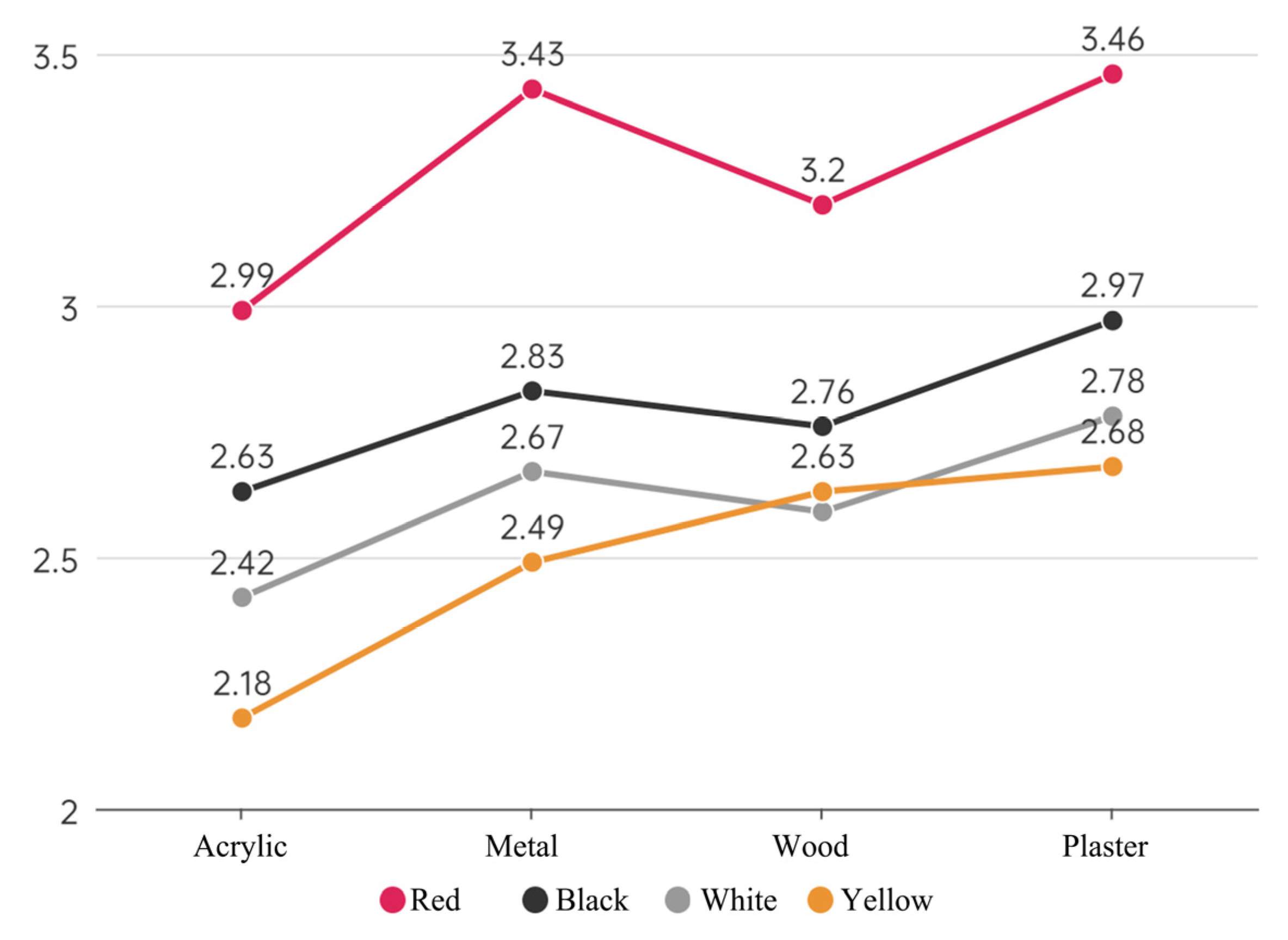
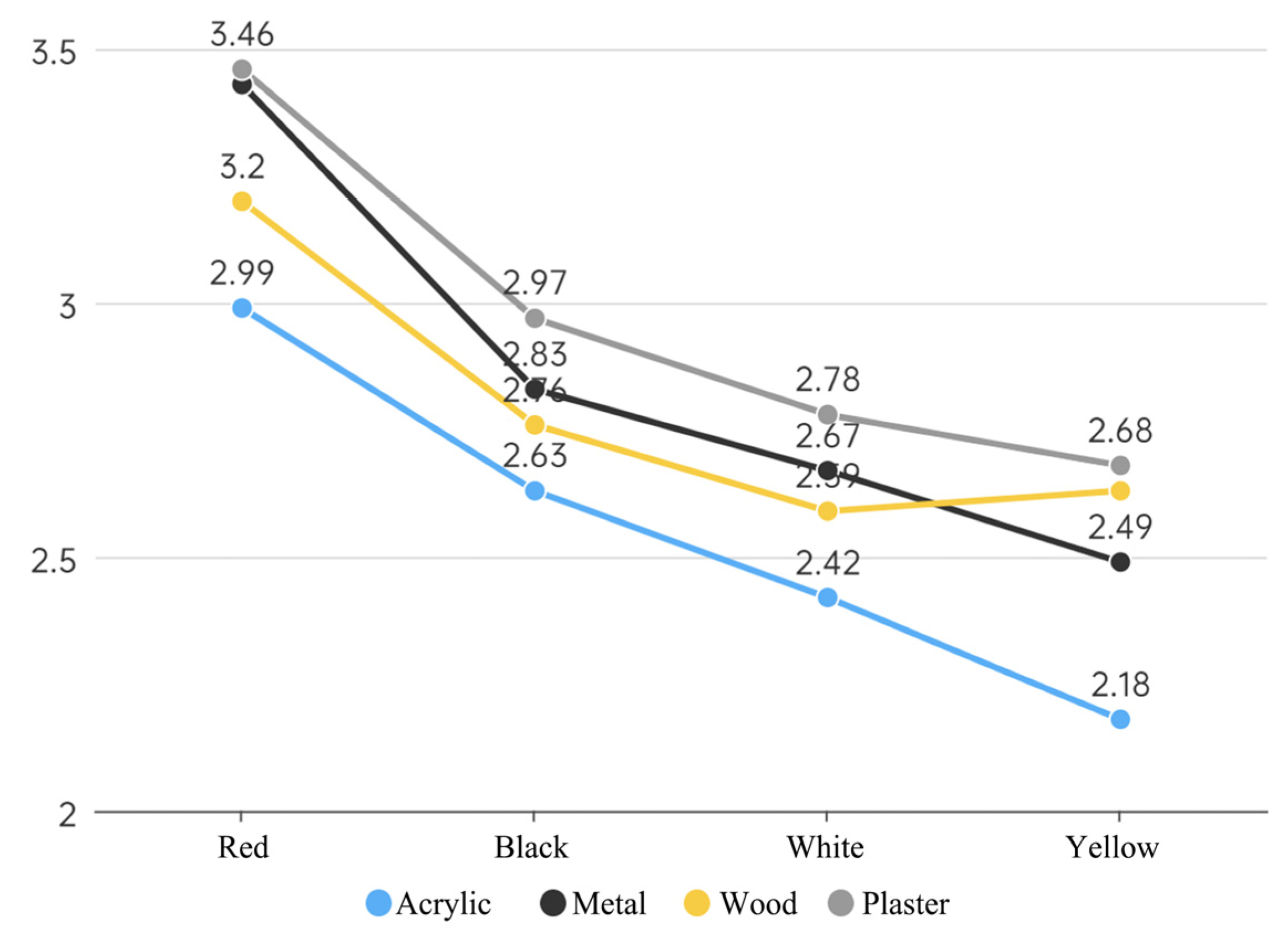
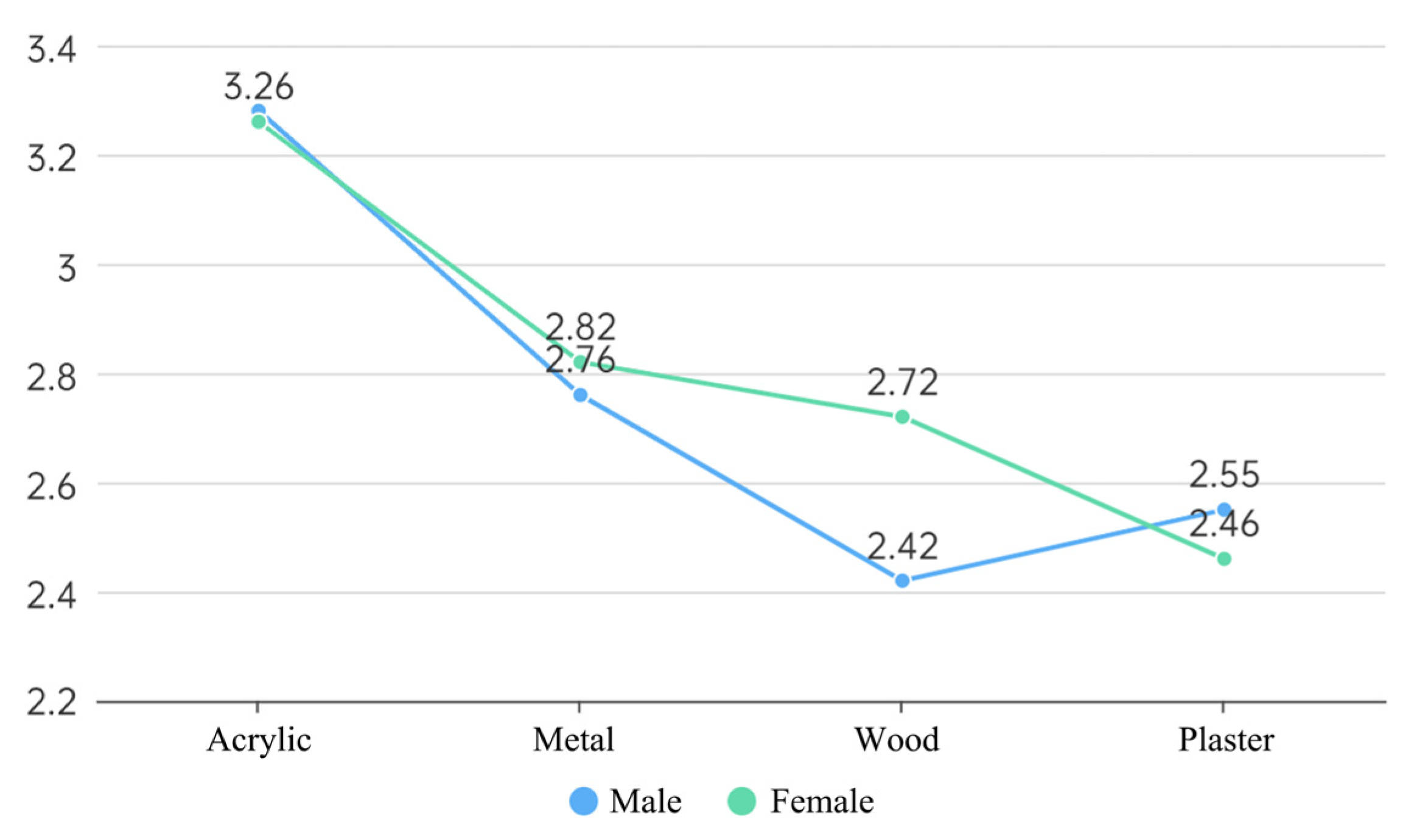
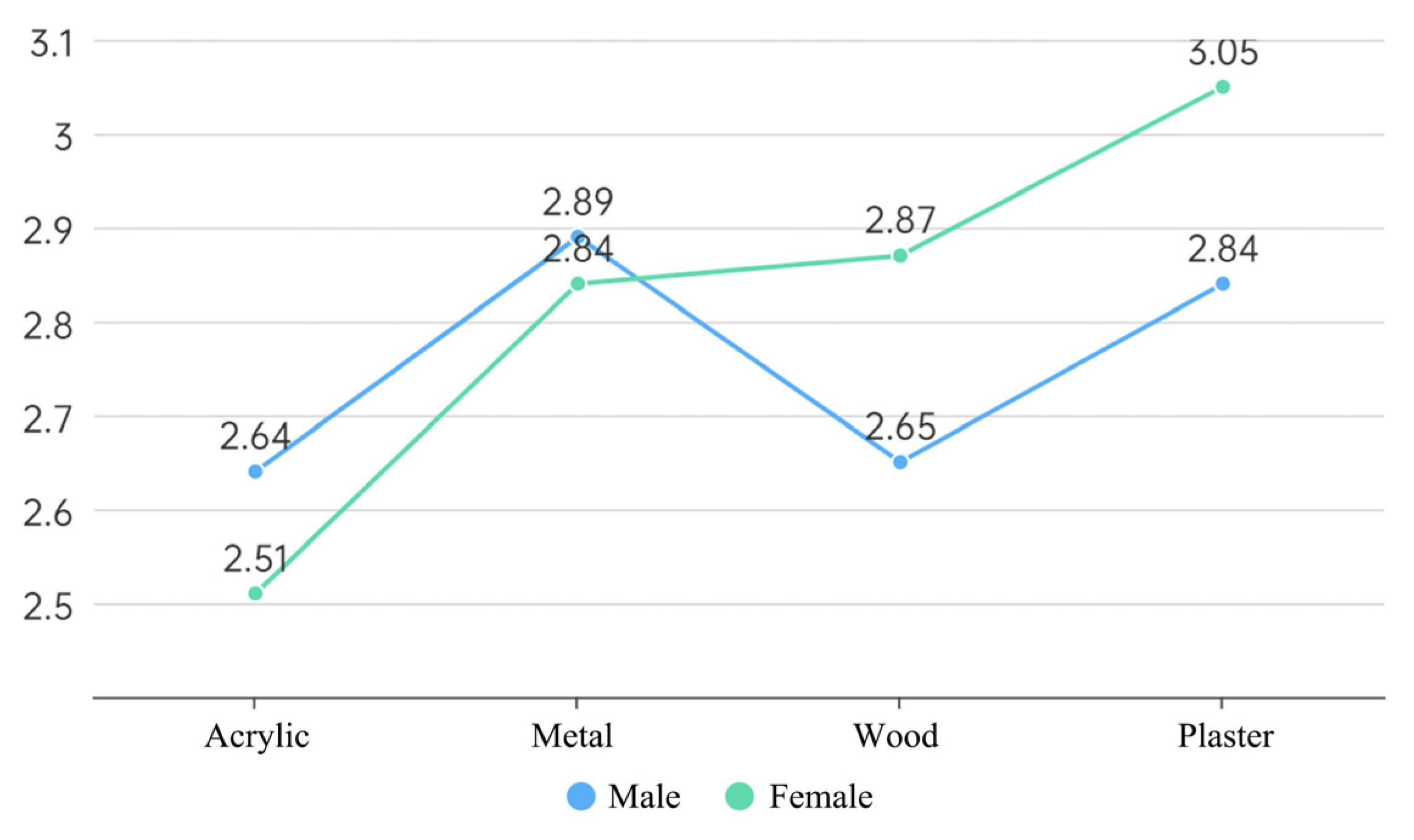

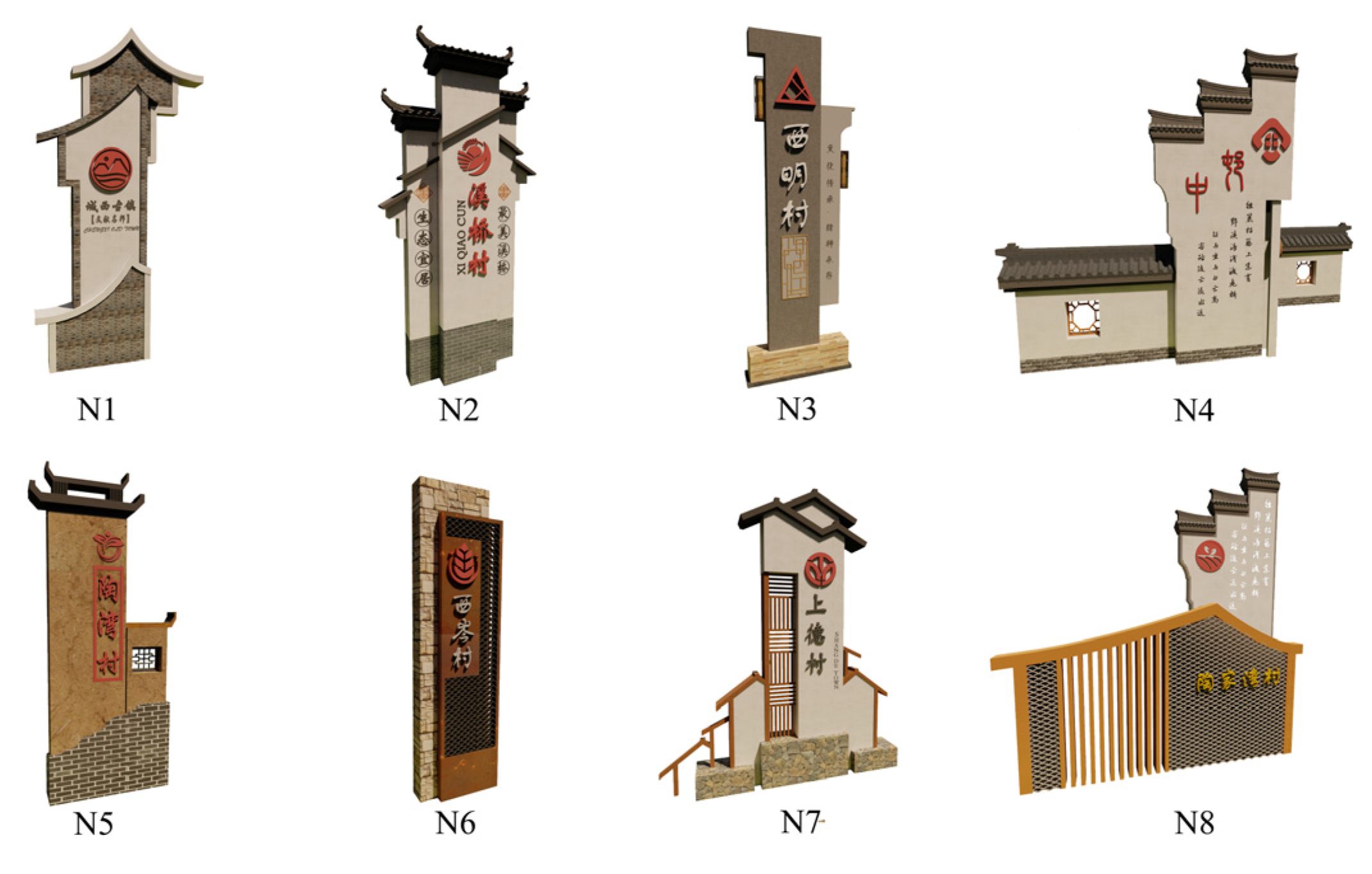
Disclaimer/Publisher’s Note: The statements, opinions and data contained in all publications are solely those of the individual author(s) and contributor(s) and not of MDPI and/or the editor(s). MDPI and/or the editor(s) disclaim responsibility for any injury to people or property resulting from any ideas, methods, instructions or products referred to in the content. |
© 2023 by the authors. Licensee MDPI, Basel, Switzerland. This article is an open access article distributed under the terms and conditions of the Creative Commons Attribution (CC BY) license (https://creativecommons.org/licenses/by/4.0/).
Share and Cite
Liu, Y.; Zhou, Z.; Xu, Y. Design Element Preferences in Public Facilities: An Eye Tracking Study. Land 2023, 12, 1411. https://doi.org/10.3390/land12071411
Liu Y, Zhou Z, Xu Y. Design Element Preferences in Public Facilities: An Eye Tracking Study. Land. 2023; 12(7):1411. https://doi.org/10.3390/land12071411
Chicago/Turabian StyleLiu, Yumeng, Zhicheng Zhou, and Yuanyuan Xu. 2023. "Design Element Preferences in Public Facilities: An Eye Tracking Study" Land 12, no. 7: 1411. https://doi.org/10.3390/land12071411
APA StyleLiu, Y., Zhou, Z., & Xu, Y. (2023). Design Element Preferences in Public Facilities: An Eye Tracking Study. Land, 12(7), 1411. https://doi.org/10.3390/land12071411





